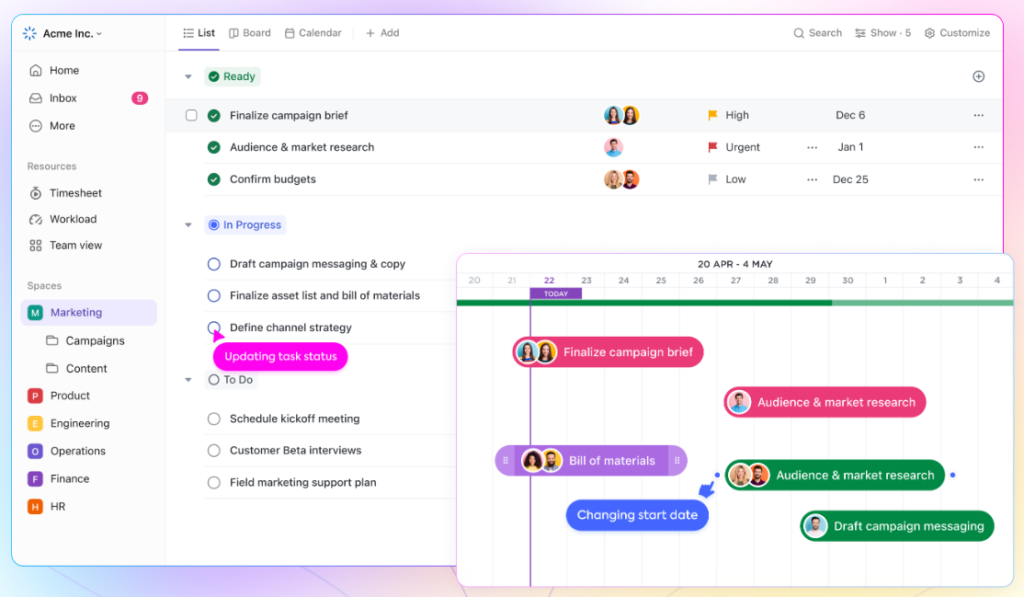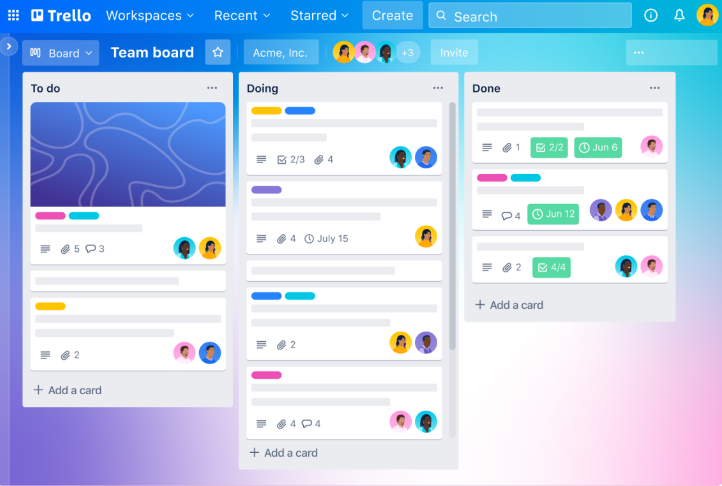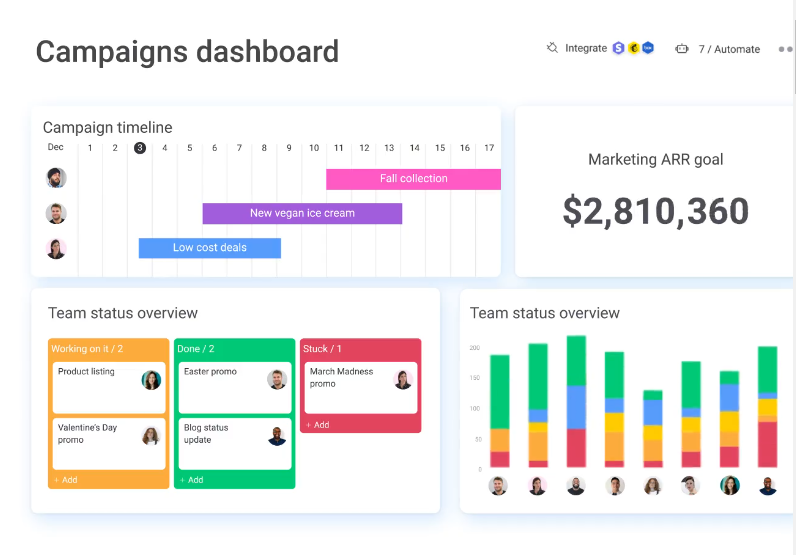Discover the Top 5 Productivity Tools to Help You Manage Tasks
Managing tasks efficiently is crucial for both personal productivity and team collaboration. Here are five top productivity tools that stand out in 2024, offering various features to help you streamline your workflow and stay organized.
1. ClickUp
Overview
ClickUp is a versatile project management tool designed to handle everything from simple to-do lists to complex project management.
Features
- Custom Dashboards: ClickUp allows you to create and customize dashboards to get an overview of your work. This feature lets you visualize data and metrics that are most important to you and your team.
- Task Management: You can manage tasks with features like task dependencies, subtasks, and checklists. This helps in breaking down complex projects into manageable parts.
- Integration: Integrates with over 1,000 tools including Slack, Google Drive, and Zoom, ensuring seamless workflow across various platforms.
- Views: Offers multiple views like Kanban, Gantt charts, and calendars to suit different project management styles.
Benefits
- Comprehensive: Combines various productivity tools in one platform, reducing the need for multiple apps.
- Flexible: Suitable for individuals, small teams, and large organizations due to its scalability.
- Collaborative: Enhances team collaboration with real-time updates, notifications, and the ability to comment on tasks.
Pricing
- Free Plan: Includes basic features suitable for individuals and small teams.
- Paid Plans: Start at $7 per user per month, offering advanced features like goal tracking, custom fields, and more.
Use Case
ClickUp is ideal for teams and organizations looking for an all-in-one solution to manage tasks, projects, and collaborate efficiently. It’s particularly useful for teams that need a high level of customization and integration with other tools.

2. Asana
Overview
Asana helps teams organize their work, from daily tasks to strategic initiatives. It is designed to improve collaboration and efficiency within teams.
Features
- Task Management: Asana lets you create tasks, set deadlines, assign them to team members, and track their progress. Tasks can be organized into projects, and projects can be divided into sections.
- Project Views: Provides different views like list, board, and calendar to manage tasks according to your preference.
- Integrations: Connects with various tools like Slack, Microsoft Teams, Google Workspace, and more, enabling seamless integration into your existing workflow.
Benefits
- User-Friendly: Easy to set up and use with a clean, intuitive interface that doesn’t require extensive training.
- Scalable: Suitable for small teams to large enterprises due to its robust features and scalability.
- Visibility: Provides clarity and transparency on task assignments, progress, and deadlines, helping teams stay aligned.
Pricing
- Free Plan: Offers basic features suitable for individuals and small teams.
- Paid Plans: Start at $10.99 per user per month, providing access to advanced features like timelines, reporting, and custom fields.
Use Case
Asana is best for teams needing a clear and intuitive tool to manage projects, track progress, and collaborate effectively. It is particularly beneficial for teams that require a straightforward way to visualize their workflow and ensure accountability.

3. Trello
Overview
Trello uses a Kanban-style board to help visualize and organize tasks. It’s known for its simplicity and visual appeal, making it a favorite among small teams and individuals.
Features
- Boards, Lists, and Cards: Organize projects with a visual board interface. Each board represents a project, lists represent stages of a project, and cards represent tasks.
- Power-Ups: Enhance functionality with integrations like Calendar, Google Drive, Slack, and more. Power-ups add extra features and customization to your boards.
- Automation: Automate repetitive tasks with Butler, Trello’s built-in automation tool. This helps save time and reduce manual effort.
Benefits
- Visual: Easy to see the status of tasks at a glance with a visual board layout.
- Flexible: Adaptable to various workflows and project types, from simple to complex.
- Collaborative: Simple for team collaboration, allowing multiple users to work on the same board, assign tasks, and comment on cards.
Pricing
- Free Plan: Includes basic features with unlimited boards, lists, and cards.
- Paid Plans: Start at $5 per user per month, offering additional features like unlimited power-ups, advanced checklists, and more.
Use Case
Trello is great for small teams and individuals who prefer a visual approach to task management. It’s especially useful for those who need a straightforward, intuitive tool to keep track of tasks and projects without a steep learning curve.

4. Notion
Overview
Notion is an all-in-one workspace that combines note-taking, project management, and task management. It allows users to create a highly customizable workspace tailored to their needs.
Features
- Customizable Workspaces: Create tailored pages and databases for various types of content, from meeting notes to project plans.
- Task Management: Track tasks with to-do lists, calendars, and Kanban boards, all within the same platform.
- Integrations: Connects with tools like Google Drive, Slack, Trello, and more, making it easy to embed content and streamline your workflow.
Benefits
- Versatile: Combines multiple functions into one platform, reducing the need for multiple apps.
- Collaborative: Share pages and collaborate in real-time with team members, making it easy to work together on projects and documents.
- Flexible: Highly customizable, allowing users to create their own templates and workflows that suit their specific needs.
Pricing
- Free Plan: For personal use, with basic features.
- Paid Plans: Start at $8 per user per month, offering additional features like unlimited team members, advanced permissions, and more.
Use Case
Notion is ideal for users who need a highly customizable tool to manage tasks, organize information, and collaborate with others. It’s particularly useful for teams and individuals who want to centralize their work in one place and tailor their workspace to their specific needs.

5. Monday.com
Overview
Monday.com is a work operating system that allows teams to run projects and workflows with confidence. It’s designed to improve team collaboration and efficiency.
Features
- Custom Workflows: Create and automate workflows to suit your project needs, from simple task lists to complex project plans.
- Visual Management: Use boards, timelines, and charts to visualize work, making it easy to see the status of projects at a glance.
- Integrations: Connect with tools like Slack, Microsoft Teams, Google Workspace, and more, ensuring seamless workflow integration.
Benefits
- Structured: Provides a clear structure for managing complex projects with multiple stakeholders and dependencies.
- Collaborative: Enhances teamwork with real-time collaboration features, including comments, mentions, and file sharing.
- Automations: Reduces manual work with automated workflows, saving time and reducing the risk of errors.
Pricing
- Free Trial: Available to test the features before committing.
- Paid Plans: Start at $8 per user per month, offering advanced features like automation, integrations, and more.
Use Case
Monday.com is best for teams and organizations that require a robust tool to manage projects and workflows with multiple stakeholders. It’s particularly useful for teams that need a structured approach to project management and want to enhance collaboration and productivity.

By using these tools, you can enhance your productivity, stay organized, and effectively manage your tasks, ensuring that you meet your goals and deadlines.



